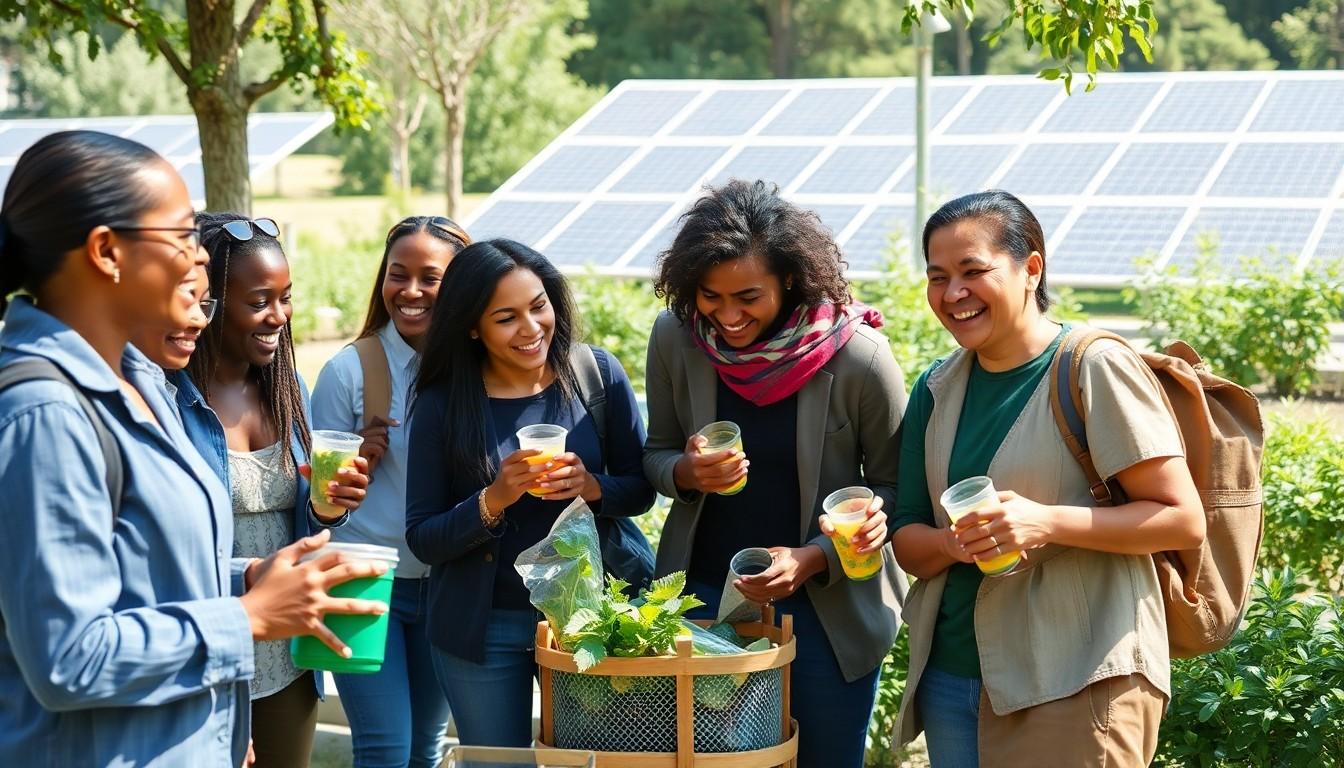
Sustainable Living Essay: Transform Your Life and Save the Planet Today
In a world where plastic seems to multiply faster than rabbits, sustainable living is no longer just a buzzword—it’s a necessity. Imagine a life where your morning coffee doesn’t come with a side of guilt and your weekend shopping spree doesn’t end with a landfill crisis. Sustainable living isn’t just about hugging trees; it’s about making smarter choices that benefit both the planet and your wallet.
Sustainable Living Essay
Sustainable living prioritizes practices that reduce one’s environmental footprint. This lifestyle seeks balance between personal needs and planetary health.
Definition of Sustainable Living
Sustainable living refers to lifestyle choices that minimize harm to the environment. Individuals engage in practices such as reducing waste, conserving energy, and supporting local economies. This approach emphasizes harmony with nature while fulfilling daily needs. Embracing sustainable living requires conscious decision-making, fostering a culture of responsibility towards the planet. It involves actions that not only benefit present generations but also ensure resources remain viable for future ones.
Importance of Sustainable Living
The importance of sustainable living lies in its ability to combat environmental challenges. Climate change resulting from resource depletion affects everyone. Transitioning to sustainable practices enables reductions in carbon footprints and waste production. Financial savings emerge through efficient use of resources; choosing energy-efficient appliances contributes to lower utility bills. Additionally, promoting biodiversity through sustainable agriculture fosters healthier ecosystems. Communities thrive when individuals adopt sustainable living, enhancing quality of life. Prioritizing sustainability offers a pathway to a more resilient and equitable future.
Key Principles of Sustainable Living

Sustainable living focuses on key practices that promote environmental well-being and economic benefits. Individuals can adopt various approaches to create a positive impact on the planet.
Reduce, Reuse, Recycle
Reducing waste starts with mindful consumption. When individuals buy only what they need, they limit excess and prevent landfill overflow. Reusing materials extends their life and reduces the demand for new products. For instance, using glass jars for storage minimizes reliance on plastic containers. Recycling plays a crucial role in conserving resources. Paper, aluminum, and plastics can be reprocessed and transformed into new products, decreasing the need for raw materials. By prioritizing these three Rs, people contribute to a healthier environment while fostering efficient use of resources.
Sustainable Energy Sources
Sustainable energy sources provide environmental solutions. Solar power stands out as a popular option for many households, harnessing sunlight for electricity and heating. Wind energy also gains traction, transforming kinetic energy from wind into usable power. Hydroelectric energy further leverages flowing water to create electricity, lessening reliance on fossil fuels. Geothermal energy utilizes heat from the Earth, offering a consistent energy supply. By integrating these renewable solutions into daily life, individuals reduce their carbon footprint and support a cleaner, more sustainable energy future.
Benefits of Sustainable Living
Sustainable living offers a range of vital benefits that impact the environment, economy, and society. Significant advantages emerge from adopting sustainable practices, contributing to a healthier planet and improved quality of life.
Environmental Benefits
Sustainable living primarily reduces environmental harm. Minimizing waste through practices like composting and recycling leads to lesser landfill contributions. Incorporating energy-efficient technologies lowers greenhouse gas emissions, directly impacting climate change mitigation. Supporting sustainable agriculture helps maintain biodiversity, fosters healthier ecosystems, and promotes soil health. By choosing local products, individuals reduce transportation emissions, further aiding environmental protection. Overall, these actions cultivate a thriving natural environment.
Economic Benefits
Adopting sustainable living practices often results in financial savings. Energy efficiency measures, such as switching to LED lighting, can lead to lower utility bills. Investing in renewable energy sources, like solar panels, often results in long-term financial benefits and energy independence. Supporting local economies typically encourages job creation, promoting community growth. Additionally, reduced consumption of resources often translates to lower overall expenditures. The financial advantages of sustainability extend beyond immediate savings.
Social Benefits
Sustainable living fosters stronger communities and enhances social well-being. Access to local food sources often improves community health through better nutrition. Collaboration in community gardens and sustainable initiatives strengthens social ties, promoting engagement and teamwork. Sustainable practices often prioritize inclusivity, providing equitable opportunities for all individuals. Healthier environments contribute to overall well-being by reducing pollution-related illnesses. Ultimately, the social fabric of communities strengthens through shared values of sustainability.
Ways to Live Sustainably
Sustainable living encompasses practical actions in daily life that minimize environmental impact. Individuals can adopt various strategies to create a sustainable future.
Sustainable Home Practices
Sustainable home practices focus on energy efficiency and waste reduction. One effective method includes using energy-efficient appliances that consume less power and reduce utility bills. Installing LED lighting lowers energy usage, while using smart thermostats optimizes heating and cooling. Reducing water waste is another priority. Simple measures, like fixing leaks and installing low-flow fixtures, save both water and money. Composting kitchen scraps transforms waste into nutrient-rich soil. Supporting local farmers through community-supported agriculture promotes sustainable food systems, which enhances local economies and reduces transportation emissions.
Sustainable Transportation Options
Choosing sustainable transportation options significantly lowers carbon footprints. Public transportation, like buses and trains, offers a cost-effective alternative to individual vehicle use. Biking or walking for short trips fosters physical health while reducing emissions. Carpooling with others not only saves money on fuel but also cuts down on traffic congestion. Electric vehicles present an innovative approach to sustainable transport, utilizing renewable energy sources. For longer journeys, exploring train travel instead of flying lowers environmental impact and often provides a scenic alternative. Implementing these transportation practices leads to healthier communities and a cleaner environment.
Challenges in Sustainable Living
Sustainable living faces several challenges that hinder widespread adoption. Misunderstandings surrounding sustainability impact individuals’ decisions.
Common Misconceptions
Some people believe sustainable living requires drastic lifestyle changes. They think it mandates expensive products or significant sacrifices. In reality, small, incremental shifts can lead to meaningful impact. Others assume sustainable practices only apply to certain demographics. However, anyone can adopt these habits, regardless of economic status. Many also equate sustainability with inconvenience, overlooking the long-term benefits of a sustainable lifestyle, like cost savings and improved health.
Barriers to Adoption
Financial constraints often present barriers to sustainable living. Affordability of eco-friendly products can deter individuals from making sustainable choices. Additionally, lack of access to resources limits opportunities for sustainable practices. Urban areas might not provide ample options for local and sustainable goods. Time constraints also play a role; busy schedules may discourage people from preparing sustainable meals or seeking eco-friendly alternatives. People may also feel overwhelmed by the amount of information available, leading to confusion and inaction.
More Sustainable Future
Embracing sustainable living isn’t just a trend; it’s a vital necessity for the health of the planet and its inhabitants. By adopting mindful practices that prioritize environmental stewardship individuals can make a tangible difference in combating climate change and fostering community resilience.
Every small action contributes to a larger movement toward sustainability. Whether it’s reducing waste conserving energy or supporting local economies these choices create a ripple effect that benefits everyone.
Ultimately sustainable living enhances quality of life while protecting the Earth for future generations. It’s a journey worth taking and one that leads to a brighter more sustainable future.
